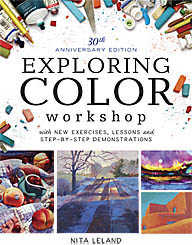Be careful what you ask about color
After six weeks of classes, reactions run the gamut from "Eureka, I've got it!" to "Now what are we supposed to do with that?" Everyone is trying to deal with the huge amount of information and to understand how they can use it. Today they indicated they would like to have a followup class, but I can't do that in the near future. Maybe next year. One student told me she went home last week and looked at a painting she had been struggling with all week and wasn't satisfied with--and immediately said to herself, "I used the wrong yellow." Problem solved. I love it when that happens. Another, who had insisted that she wasn't too thrilled with the idea of changing her palette came up with eight variations of compatible primaries--six were mine and the other two she had worked out herself. We have two more classes, but they're alternating with events at the gallery, so we miss next week and the first week in May. Then I'm taking four weeks off from teaching. I'll probably get together with the Monday class, as some of them paint together when there is no class.





4 Comments:
re: Everyone is trying to deal with the huge amount of information and to understand how they can use it.
I've concentrated on digital art. Basic ideas of hue, saturation, and brightness---each gently tweaked and experimented upon---give millions and millions of variations. It's no wonder we can get overwhelmed. And those many variations might only be in a monochrome work. Then begin to combine the colors. It can be overwhelming unless you learn the art of limiting your palette.---BobOLink
Limiting your palette is pretty much what exploring color is about. When I teach beginners my split-primary color-mixing system I know they could paint forever with just six colors plus burnt sienna. But artists usually want their "own" color palettes, plus a few personal choices. I teach them how to test paint characteristics of many colors so they can find the combinations that work best for them.
Limiting your palette is pretty much what exploring color is about. I like that, but it probably sounds like a paradox to someone who's a beginner. When we usually think of "exploring," we think of freedom to go any direction. But without some limits, the exploration will end up nowhere or with frustrating results. Maybe a parallel is space exploration. It's certainly more interesting to explore by aiming the rocket at Mars or the Moon, rather than a random spot in the night sky, which might just put the NASA in a messy nowhere that is more likely to be a failure than a success.
---BobOlink
Hmmm. If you come back down to earth, exploring can mean simply trying something new, no matter how small. You usually have to start small to accomplish big things. My beginning watercolor students don't have to deal with all the information the color class is working with. Beginners master the split-primaries first. It's simple, logical and it works.
Post a Comment
<< Home